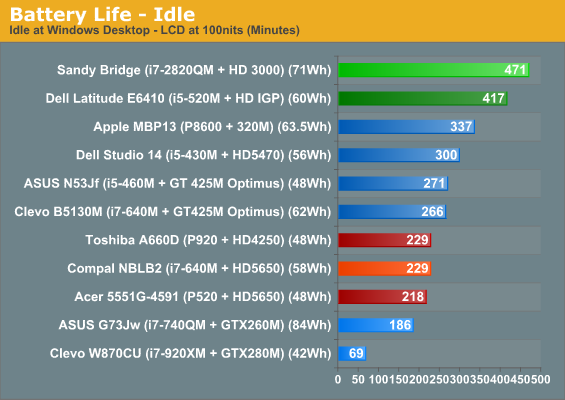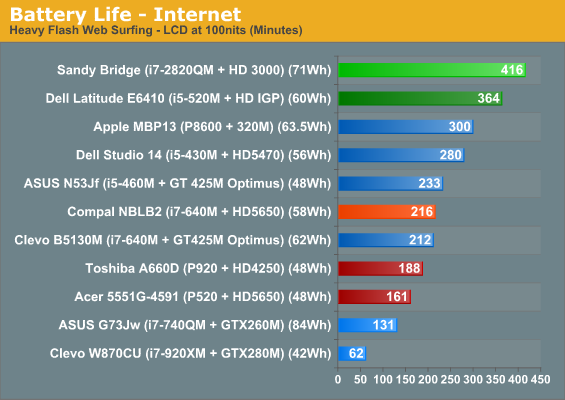Intel’s Sandy Bridge i7-2820QM: Upheaval in the Mobile Landscape
by Jarred Walton on January 3, 2011 12:00 AM EST- Posted in
- Laptops
- Intel
- Sandy Bridge
- Compal
All the Performance, and Good Battery Life As Well!
We’ve just finished showing that CPU and GPU performance has basically more than doubled compared to last year’s Arrandale offerings. That’s great news, but what happens to battery life? We’ve got 35W TDP Arrandale parts compared to a 45W TDP Sandy Bridge quad-core; doesn’t that mean battery life will decrease by around 25%? The answer is happily no; as we’ve point out in the past, TDP isn’t really a useful measurement of power requirements. All the TDP represents in this case is the maximum amount of power Sandy Bridge should draw. So worst-case battery life under full load might drop, but the real question is going to be what happens under typical workloads.
Intel’s use of power gating and variable clock speeds is put to good use, with the result being battery life that is nothing short of exceptional when compared to previous generation products. We’ve seen ULV and Atom netbooks and ultraportables get battery life into the 8+ hour range, but such designs have always required serious compromise in the performance department. SNB certainly won’t beat out Atom for pure battery life, but that doesn’t mean it’s a power hog. Our Compal test system comes with a 71Wh battery, which is larger than what we’ve seen in many 15.6” and smaller designs but still reasonable for a 17.3” chassis. Here are the results of our standard battery life testing.




Yes, those figures are accurate. Best-case, running at 100nits, quad-core Sandy Bridge still lasted nearly eight hours on a single charge! What’s more interesting is that our standard Internet battery life test that loads four pages with Flash ads every sixty seconds still checks in just shy of seven hours. Finally, H.264 playback also comes in at the top of our charts, providing more than four hours of demanding video playback. If 240 minutes of content off your HDD/SSD isn’t enough, we also were able to watch a Blu-ray disc and still get 220 minutes of 35Mbit VLC playback. Wow!
So Sandy Bridge comes out on the top of the above charts, but we didn’t include some of the other long battery life alternatives. Just to put things in perspective, ASUS’ U30JC—with an SSD and an 84Wh battery—has long been our king for matching reasonable performance with long battery life. It managed 588 minutes idle, 476 minutes Internet, and 254 minutes H.264 playback. That’s 25% more idle life, but only 14% better Internet and actually slightly lower H.264 battery life, and you need to factor in the 18% higher capacity battery and 13.3” (versus 17.3”) LCD.
We have to wonder just how small of a form factor manufacturers can manage to cram the quad-core Sandy Bridge into. Idle and low usage power requirements are clearly very good, but with maximum TDP still at 45W the chassis needs to be able to handle the heat. We’d really love to see some 14” designs with quad-core CPUs, and the icing on the cake would be sticking a reasonably fast discrete GPU with graphics switching technology into the case as well. Intel doesn’t have any LV/ULV quad-core parts listed—yet!—so we may have to wait for ultraportable quad-core laptops, but certainly 15.6” designs should be able to combine SNB with reasonably fast Optimus GPUs to provide an optimal blend of performance and mobility.










66 Comments
View All Comments
seamusmc - Friday, January 7, 2011 - link
I'm a notebook noob, up till now I've avoided them as much as I could. I have evaluated them over the years and have a pretty good dell precision 4500 at work, however, I had to build a desktop because the laptop, as provided, just doesn't cut it. With a SSD and 8 GB of ram it would probably suffice but I run a lot of Virtual Machines for testing.Anyhoo, enough of my background: I am very interested in the Sandy Bridge line specifically the retail chips, 2720 and 2820.
However all I'm seeing announced from the OEM's are 2630 based solutions. Are the OEM's going to have an option to upgrade to the retail chips? Are the 2720 and 2820 going to be available any time soon or is it just the 2630 that will have broad availability?
Who will have the retail chips available?
GullLars - Saturday, January 8, 2011 - link
This review unit came with an Intel SSD, which probably made a huge impact on general usage, but can we expect SSD boot drives for most Sandy Bridge laptops?If i were Intel, i'd make a branding program where Sandy + Intel SSD (310, G2, or newer) gave a fancy sticker for marketers to drool over, guaranteeing smooth and snappy operation without hiccups from spinning platter IOs.
IntoGraphics - Monday, January 17, 2011 - link
"We might get some of the above in OEM systems sent for review, and if so it will be interesting to see how much of an impact the trimmed clock speeds have on overall performance."Looking forward for this to happen. Very important to know for me. Because I will be using Adobe Illustrator CS4, Cinema 4D R12 Prime, and Unity 3D.
I hope that the performance impact between an i7-2720QM and a i7-2820QM, is as minimal as it was between the i7-740QM and i7-840QM.
It's going to be a toss up between the SB Dell XPS 17 and the SB HP Envy 17 for me, combined with a Dell or HP 30" monitor. Just too bad that both notebooks will not offer 1920x1200 resolution.
psiboy - Wednesday, January 19, 2011 - link
Your gaming benchmark is a joke! Anyone who has a radeon 5650m in there laptop isn't going to set game setting to "Ultra Low" a good mid range setting would have been more realistic and probably playable... but the Intel HD graphics on Sandy Bridge would not have looked so good then.... "Lies, damned lies and statistics!" all manipulated so the uneducated are taken in to think they can game on Intel IGP's....BTW: Dirt 2 looks like crap on Ultra Low...
katleo123 - Tuesday, February 1, 2011 - link
It works on new motherboards based on Intel’s forthcoming 6-series chipsetsVisit http://www.techreign.com/2010/12/intels-sandy-brid...
welcomesorrow - Friday, June 10, 2011 - link
Hi,I would mostly appreciate your suggestions regarding the bottleneck of overclocked QSV.
I have Core i5-2400s on Intel's DH67BL (H67) mother and have been using Media Espresso 6.5 to transcode ts files (MPEG-2) into H.264 by QSV. DH67BL allows me to overclock the graphics core from its default 1.1GHz to 2GHz. I observe linear shortening of transcoding time from 43 seconds/GB (1.1GHz) to 35 seconds/GB (1.6GHz), but beyond that there is no further improvement. Thus, it is expected to be transcoding in 30 seconds/GB at 2GHz but in reality it takes 35 seconds/GB.
QSV encoding in Media Espresso 6.5 is already ultrafast, and first I thought it might be hitting the I/O bandwidth of HDD, but it was not the case because SSD or even RAMDISK did not improve the situation.
Any idea about what is becoming the bottleneck of overclocked QSV? My guess is that it has something to do with either Sandy Bridge's internal hardware (such as data transfer) or Media Espresso's logic or both.